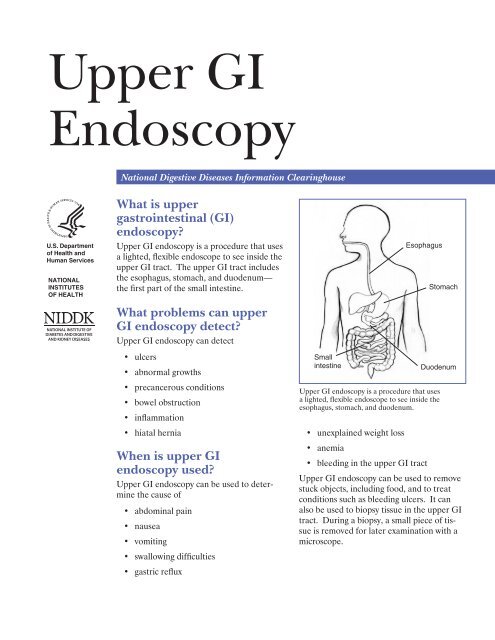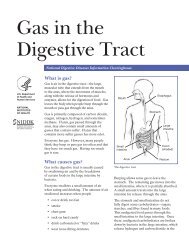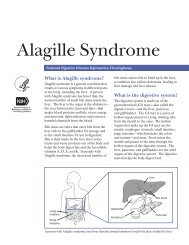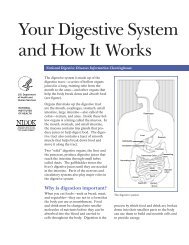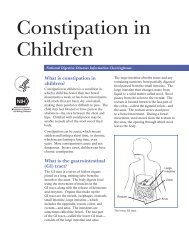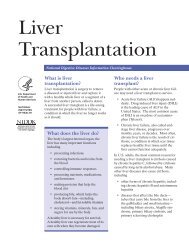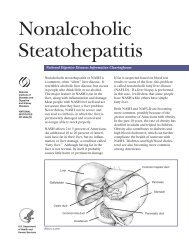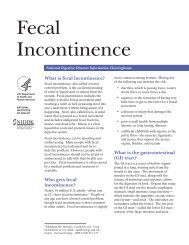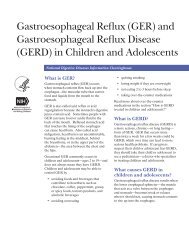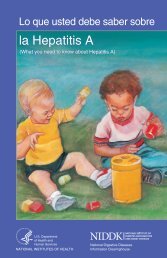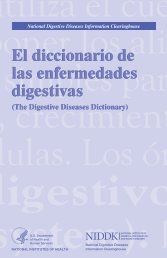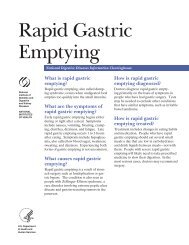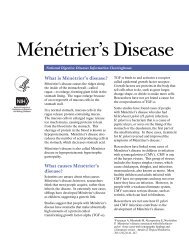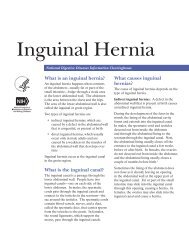You also want an ePaper? Increase the reach of your titles
YUMPU automatically turns print PDFs into web optimized ePapers that Google loves.
<strong>Upper</strong> <strong>GI</strong> <strong>Endoscopy</strong>National Digestive Diseases Information ClearinghouseU.S. Departmentof Health andHuman ServicesNATIONALINSTITUTESOF HEALTHWhat is uppergastrointestinal (<strong>GI</strong>)endoscopy?<strong>Upper</strong> <strong>GI</strong> endoscopy is a procedure that usesa lighted, flexible endoscope to see inside theupper <strong>GI</strong> tract. The upper <strong>GI</strong> tract includesthe esophagus, stomach, and duodenum—the first part of the small intestine.What problems can upper<strong>GI</strong> endoscopy detect?<strong>Upper</strong> <strong>GI</strong> endoscopy can detect• ulcers• abnormal growths• precancerous conditions• bowel obstruction• inflammation• hiatal herniaWhen is upper <strong>GI</strong>endoscopy used?<strong>Upper</strong> <strong>GI</strong> endoscopy can be used to determinethe cause of• abdominal pain• nausea• vomiting• swallowing difficulties• gastric refluxSmallintestineEsophagus<strong>Upper</strong> <strong>GI</strong> endoscopy is a procedure that usesa lighted, flexible endoscope to see inside theesophagus, stomach, and duodenum.• unexplained weight loss• anemia• bleeding in the upper <strong>GI</strong> tractStomachDuodenum<strong>Upper</strong> <strong>GI</strong> endoscopy can be used to removestuck objects, including food, and to treatconditions such as bleeding ulcers. It canalso be used to biopsy tissue in the upper <strong>GI</strong>tract. During a biopsy, a small piece of tissueis removed for later examination with amicroscope.
How to Prepare for <strong>Upper</strong><strong>GI</strong> <strong>Endoscopy</strong>The upper <strong>GI</strong> tract must be empty beforeupper <strong>GI</strong> endoscopy. Generally, no eatingor drinking is allowed for 4 to 8 hours beforethe procedure. Smoking and chewing gumare also prohibited during this time.Patients should tell their doctor about allhealth conditions they have—especially heartand lung problems, diabetes, and allergies—and all medications they are taking. Patientsmay be asked to temporarily stop takingmedications that affect blood clotting orinteract with sedatives, which are often givenduring upper <strong>GI</strong> endoscopy.Medications and vitamins that may berestricted before and after upper <strong>GI</strong> endoscopyinclude• nonsteroidal anti-inflammatory drugssuch as aspirin, ibuprofen (Advil), andnaproxen (Aleve)• blood thinners• blood pressure medications• diabetes medications• antidepressants• dietary supplementsDriving is not permitted for 12 to 24 hoursafter upper <strong>GI</strong> endoscopy to allow sedativestime to completely wear off. Before theappointment, patients should make plans fora ride home.How is upper <strong>GI</strong> endoscopyperformed?<strong>Upper</strong> <strong>GI</strong> endoscopy is conducted at a hospitalor outpatient center.Patients may receive a local, liquid anestheticthat is gargled or sprayed on the back of thethroat. The anesthetic numbs the throatand calms the gag reflex. An intravenous(IV) needle is placed in a vein in the armif a sedative will be given. Sedatives helppatients stay relaxed and comfortable. Whilepatients are sedated, the doctor and medicalstaff monitor vital signs.During the procedure, patients lie on theirback or side on an examination table. Anendoscope is carefully fed down the esophagusand into the stomach and duodenum. Asmall camera mounted on the endoscopetransmits a video image to a video monitor,allowing close examination of the intestinallining. Air is pumped through the endoscopeto inflate the stomach and duodenum, makingthem easier to see. Special tools thatslide through the endoscope allow the doctorto perform biopsies, stop bleeding, andremove abnormal growths.2<strong>Upper</strong> <strong>GI</strong> <strong>Endoscopy</strong>
Recovery from <strong>Upper</strong> <strong>GI</strong><strong>Endoscopy</strong>After upper <strong>GI</strong> endoscopy, patients aremoved to a recovery room where they waitabout an hour for the sedative to wear off.During this time, patients may feel bloatedor nauseated. They may also have a sorethroat, which can stay for a day or two.Patients will likely feel tired and should planto rest for the remainder of the day. Unlessotherwise directed, patients may immediatelyresume their normal diet and medications.Some results from upper <strong>GI</strong> endoscopy areavailable immediately after the procedure.The doctor will often share results withthe patient after the sedative has worn off.Biopsy results are usually ready in a few days.What are the risksassociated with upper <strong>GI</strong>endoscopy?Risks associated with upper <strong>GI</strong> endoscopyinclude• abnormal reaction to sedatives• bleeding from biopsy• accidental puncture of the upper <strong>GI</strong>tractPatients who experience any of the followingrare symptoms after upper <strong>GI</strong> endoscopyshould contact their doctor immediately:• swallowing difficulties• throat, chest, and abdominal pain thatworsens• vomiting• bloody or very dark stool• fever3 <strong>Upper</strong> <strong>GI</strong> <strong>Endoscopy</strong>
Points to Remember• <strong>Upper</strong> gastrointestinal (<strong>GI</strong>) endoscopyis a procedure that uses a lighted, flexibleendoscope to see inside the upper<strong>GI</strong> tract.• To prepare for upper <strong>GI</strong> endoscopy, noeating or drinking is allowed for 4 to8 hours before the procedure. Smokingand chewing gum are also prohibited.• Patients should tell their doctor about all health conditions they have and all medications they are taking. • Driving is not permitted for 12 to24 hours after upper <strong>GI</strong> endoscopyto allow the sedative time to wear off.Before the appointment, patients shouldmake plans for a ride home.• Before upper <strong>GI</strong> endoscopy, the patientwill receive a local anesthetic to numbthe throat.• An intravenous (IV) needle is placedin a vein in the arm if a sedative will begiven.• During upper <strong>GI</strong> endoscopy, an endoscopeis carefully fed into the upper <strong>GI</strong>tract and images are transmitted to avideo monitor.• Special tools that slide through theendoscope allow the doctor to performbiopsies, stop bleeding, and removeabnormal growths.• After upper <strong>GI</strong> endoscopy, patients mayfeel bloated or nauseated and may alsohave a sore throat.• Unless otherwise directed, patients mayimmediately resume their normal dietand medications.• Possible risks of an upper <strong>GI</strong> endoscopyinclude abnormal reaction to sedatives,bleeding from biopsy, and accidentalpuncture of the upper <strong>GI</strong> tract.Hope through ResearchThe National Institute of Diabetes andDigestive and Kidney Diseases (NIDDK)conducts and supports basic and clinicalresearch into many digestive disorders.Participants in clinical trials can play a moreactive role in their own health care, gainaccess to new research treatments beforethey are widely available, and help others bycontributing to medical research. For informationabout current studies, visitwww.ClinicalTrials.gov.For More InformationFact sheets about other diagnostic testsare available from the National DigestiveDiseases Information Clearinghouse atwww.digestive.niddk.nih.gov, including• Colonoscopy• ERCP (Endoscopic Retrograde Cholangiopancreatography) • Flexible Sigmoidoscopy• Liver Biopsy• Lower <strong>GI</strong> Series• <strong>Upper</strong> <strong>GI</strong> Series• Virtual ColonoscopyAmerican College of GastroenterologyP.O. Box 342260Bethesda, MD 20827–2260Phone: 301–263–9000Fax: 301–263–9025Email: info@acg.gi.orgInternet: www.acg.gi.org4 <strong>Upper</strong> <strong>GI</strong> <strong>Endoscopy</strong>
American Gastroenterological Association4930 Del Ray AvenueBethesda, MD 20814Phone: 301–654–2055Fax: 301–654–5920Email: member@gastro.orgInternet: www.gastro.orgAmerican Society for Gastrointestinal<strong>Endoscopy</strong>1520 Kensington Road, Suite 202Oak Brook, IL 60523Phone: 630–573–0600Fax: 630–573–0691Email: info@asge.orgInternet: www.asge.orgSociety of American GastrointestinalEndoscopic Surgeons11300 West Olympic Boulevard, Suite 600Los Angeles, CA 90064Phone: 310–437–0585Fax: 310–437–0585Email: sagesweb@sages.orgInternet: www.sages.orgYou may also find additional information about this topic by• searching the NIDDK Reference Collection atwww.catalog.niddk.nih.gov/resources• visiting MedlinePlus at www.medlineplus.govThis publication may contain information about medications. When prepared, this publicationincluded the most current information available. For updates or for questions about any medications,contact the U.S. Food and Drug Administrationtoll-free at 1–888–INFO–FDA (1–888–463–6332) or visit www.fda.gov. Consult your doctor for more information.The U.S. Government does not endorse or favor anyspecific commercial product or company. Trade,proprietary, or company names appearing in thisdocument are used only because they are considerednecessary in the context of the information provided.If a product is not mentioned, the omission does notmean or imply that the product is unsatisfactory.AcknowledgmentsPublications produced by the Clearinghouseare carefully reviewed by both NIDDKscientists and outside experts. This publicationwas reviewed by Michael Wallace, M.D.,Mayo Clinic.5 <strong>Upper</strong> <strong>GI</strong> <strong>Endoscopy</strong>
National Digestive DiseasesInformation Clearinghouse2 Information WayBethesda, MD 20892–3570Phone: 1–800–891–5389TTY: 1–866–569–1162Fax: 703–738–4929Email: nddic@info.niddk.nih.govInternet: www.digestive.niddk.nih.govThe National Digestive Diseases InformationClearinghouse (NDDIC) is a service of theNational Institute of Diabetes and Digestiveand Kidney Diseases (NIDDK). TheNIDDK is part of the National Institutes ofHealth of the U.S. Department of Healthand Human Services. Established in 1980,the Clearinghouse provides informationabout digestive diseases to people withdigestive disorders and to their families,health care professionals, and the public.The NDDIC answers inquiries, develops anddistributes publications, and works closelywith professional and patient organizationsand Government agencies to coordinateresources about digestive diseases.This publication is not copyrighted. The Clearinghouseencourages users of this fact sheet to duplicate anddistribute as many copies as desired.This fact sheet is also available atwww.digestive.niddk.nih.gov.U.S. DEPARTMENT OF HEALTHAND HUMAN SERVICESNational Institutes of HealthNIH Publication No. 09–4333May 2009


